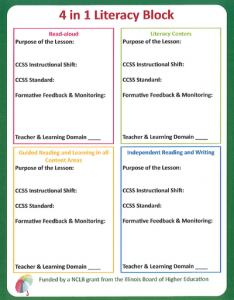Easy to use blocks for your literacy centers.
Debate Centers
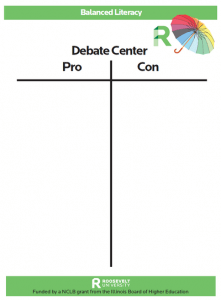 The debate center is one strategy in which to promote the development of argument and debate. This center can remain up all year in classrooms while changing the topic of debate on a weekly basis. Social justice can be the perfect starting point as students work on teams to develop opinions and arguments to debate. Students at centers are engaged in rigorous conversations based both on the informational text readings and their own personal experiences.
The debate center is one strategy in which to promote the development of argument and debate. This center can remain up all year in classrooms while changing the topic of debate on a weekly basis. Social justice can be the perfect starting point as students work on teams to develop opinions and arguments to debate. Students at centers are engaged in rigorous conversations based both on the informational text readings and their own personal experiences.
Tips on How to Implement in the Classroom:
- Make sure that the students understand what a debate is,
- Provide clear directions, rules, and roles for the center
- Include informational text and other sources (video & more), and
- Make sure that the students include the evidence from the sources to build their arguments.
Moving Toward A Justice-Driven Curriculum In The Balanced Literacy Classroom
 By Margaret Mary Policastro, Diane Mazeski, and Noreen Wach
By Margaret Mary Policastro, Diane Mazeski, and Noreen Wach
This material is derived from discussions that took place when 5th- through 8th-grade students were getting ready for an interactive read-aloud and being introduced to the book 15 on the Road to Freedom: My Story of the 1965 Selma Voting Rights March by Lynda Blackmon Lowery (2016). Hearing these questions posed, we were quite curious and interested in how the students would react as the teacher asked them to write their responses on a white board. As we moved around to get a glimpse and catch the responses, the students were engaged, serious, and appropriate. The responses included a range of topics such as “Human Rights,” “Equality,” “Animal Kindness,” “Freedom,” and “World Peace” (see Figure 1).
Read More: Moving Toward a Justice Driven Curriculum
The New Word Walls To Language Walls
 Language Walls are Word Walls expanded to a more sophisticated level to include ideas, notions, images, and much more, providing for deeper discussions. Language walls foster both social and academic discourse, allowing the teacher to document specific aspects of language. These walls allow for building vocabulary in all content areas. The focus of a language wall is on language generation by the students which create new information and understanding about the world.
Language Walls are Word Walls expanded to a more sophisticated level to include ideas, notions, images, and much more, providing for deeper discussions. Language walls foster both social and academic discourse, allowing the teacher to document specific aspects of language. These walls allow for building vocabulary in all content areas. The focus of a language wall is on language generation by the students which create new information and understanding about the world.
Check out the Word Walls to Language Walls article by Dr. Margaret Policastro for more information.
Discourse: The Importance Of Talk In The Balanced Literacy Classroom
By Margaret Mary Policastro, Roosevelt University, Chicago, Illinois
During a classroom book club discussion in our university summer reading clinic, the students we were observing had just moved their chairs into a circle to discuss The WatsonsGo to Birhmingham — 1963 and, even before they were in place, the students were eagerly discussing the book. In this open forum discussion, they were saying “I can’t believe this happened …,” “I was so sad when I read…” and “I thought it was so funny when …” Even class conversation outside of the book club seemed to be connected to the book. For example, “My dad did this funny thing last night, and it reminded me of the Watsons …” The students were eager to share and respond to each other about funny events, sad events, and much more. Parents also commented on how the children were discussing the book at home.
Read more: IRCJ Discourse Corrected
Creating Parent Libraries: Enhancing Family Literacy Through Access To Books
By Margaret Mary Polieastro, Diane K. Mazeski, and Becky McTague
Imagine walking into a school and the first thing you see is an inviting parent library where books are displayed and celebrated. This would be a place where parents can check out children’s books or read a book and find information about family literacy.
It has been our goal to assist reading specialists and literacy coaches to develop and create such parent libraries within the schools and districts where they work. The last several years have provided an outstanding opportunity for us to work in a large urban public school district. Most recently, we have focused our attention and efforts on understanding and creating a structure or framework for access to books for parents through designing and implementing parent libraries. This critical and essential access to books requires a confluence of ideas that bridges libraries within a school and provides access to books for families and caregivers.
Thus, the notions and ideas of family literacy permeate throughout our work and efforts. Family literacy is based on the idea that parents and children learn best when learning together and, through this process, both parents and children develop essential skills. Furthermore, this approach to literacy has been identified as a potential strategy for ameliorating the challenges of low levels of literacy and poverty (National Early Literacy Panel, 2008). The purpose of this column is to introduce the idea of developing and creating parent libraries and to provide descriptions, elements, photographs, references, and a checklist. Further, we showcase several parent libraries—one recently created and another that has long been in existence as an exemplar model.
Read more: Creating Parent Libraries IRCJ Article
Comprehensive Literacy Basics: An Anthology By Capstone Professional
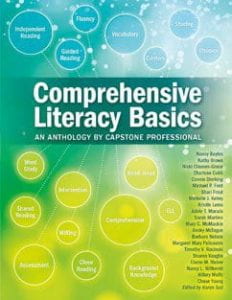 This book, compiled by experts in the filed of literacy language arts education, will provide support for educators as well as valuable knowledge in literacy development in areas such as language arts block, including whole group, small group, writing, and differentiation. Capstone publishing ensures “the quick tips and suggestions within will reinforce current practices while providing an invaluable go-to reference” (capstonepub.com).
This book, compiled by experts in the filed of literacy language arts education, will provide support for educators as well as valuable knowledge in literacy development in areas such as language arts block, including whole group, small group, writing, and differentiation. Capstone publishing ensures “the quick tips and suggestions within will reinforce current practices while providing an invaluable go-to reference” (capstonepub.com).
Living Literacy At Home: A Parent’s Guide
How to implement Living Literacy at Home
The joy of reading continues at home — in the kitchen, doing the laundry, painting a room, wherever!
What a wonderful book to share on parent’s night, at open house, during parent-teacher conferences, and in your newsletter’s home. Parents are partners in education and the tips and strategies in this book will strengthen the home-to-school alliance.
Discuss the book in a staff meeting and decide what might be included in the weekly principal’s newsletter. Ask your students to share their favorite stories that are read at home. Ask your parents to volunteer and come and read to the class. Children should view their parents as life long learners. You may need to help prepare the parent before, perhaps showing them a few techniques you use to model reading.
Have fun! Read together!
Buy this book!
The New Balanced Literacy School: Implementing The Common Core
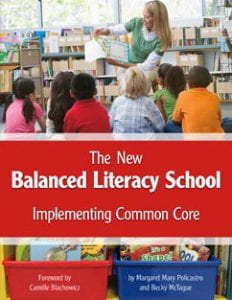 This book, authored by Dr. Margaret Policastro and Dr. Becky McTague, infuses best practices of the new balanced literacy model through the lens of Common Core with support in read-alouds, independent reading and writing, language and literacy, and several other areas.
This book, authored by Dr. Margaret Policastro and Dr. Becky McTague, infuses best practices of the new balanced literacy model through the lens of Common Core with support in read-alouds, independent reading and writing, language and literacy, and several other areas.
This must-read book will be the vehicle that will take you through the process of meeting the new instructional demands of the Common Core State Standards in the new balanced literacy model. This book can be used as a solo read or as a professional read for you and your colleagues. It doesn’t matter where in the process you are of looking at your practice with a new lens. Live with a chapter at a time, take notes in the margins, bring questions to your teaching partners, provide successes, and “rethinks” at your meetings. Hard to find common time to meet? You can create a web document and meet virtually. Additionally there is an educational goldmine of goodies in the appendices.
Formative Assessment In The New Balanced Literacy Classroom
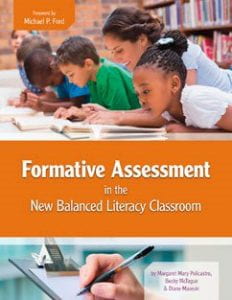 It is true that “assessment drives instruction”. This resource, authored by Dr. Margaret Policastro, Dr. Becky McTague, and Dr. Diane Mazeski, can easily be used as a professional read for teachers, staff and administrators. The seven chapters can be assigned to read for grade level meetings, grade band meetings, jigsaw activities for faculty meetings. These readings should be used to build capacity, deprivatize instruction and develop rich conversations. Nothing happens overnight in changing a culture of a school. This book will guide you through the steps. Be patient, change will come.
It is true that “assessment drives instruction”. This resource, authored by Dr. Margaret Policastro, Dr. Becky McTague, and Dr. Diane Mazeski, can easily be used as a professional read for teachers, staff and administrators. The seven chapters can be assigned to read for grade level meetings, grade band meetings, jigsaw activities for faculty meetings. These readings should be used to build capacity, deprivatize instruction and develop rich conversations. Nothing happens overnight in changing a culture of a school. This book will guide you through the steps. Be patient, change will come.
